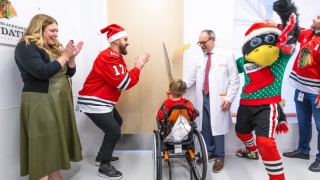Body
Useful Technology for Upper Limb Disabilities
Using household devices such as a television, light switch, computer keyboard and mouse can be difficult or impossible for people with arm or hand disabilities. There are many types of equipment now available to provide assistance as described below. For more information on equipment and techniques, consult with an occupational therapist who specializes in assistive technology.
Direct Selection
One category of technology is called direct selection. These methods are usually the easiest and most intuitive. Examples of direct selection include:
- Pushing a button on a remote control
- Pressing a key on a keyboard or making a selection on a touch screen of a communication device with one finger
- Using a mouth stick on a keyboard
- Using a mouse or a trackball to point to letters on an on-screen keyboard
- Head pointing using an electronic head pointer
- Eyegaze system for access to a computer or communication system
Some methods can be combined with computer software (such as abbreviation expansion or word prediction) to improve speed.
Switch Access
When a disability does not allow direct selection methods, or if they are too difficult, then switch access may be an option. Switches can be used to activate a variety of devices and can be matched with any available motion such as movement of the head, arm, small finger, knee or foot; a sip or a puff of breath. Users with profound motor disability may be able to access higher technology switches or other options through proximity, electromyography signals or even electroencephalogram signals.
Switch access devices usually work by scanning. For example, for television, the user activates an adaptive remote control that responds to a switch. The switch starts an automatic scan. A light or other indicator then moves between options: “Power”…”Channel Up”…”Channel Down”…”Volume Up” and so on. When the indicator is on the desired function, user activates the switch again. The remote then sends that signal to the television.
Similarly, a communication device can use a switch to scan between letters of the alphabet or pre-stored messages. A computer on-screen keyboard can be set up to scan letters of the alphabet or mouse functions. Using a single switch, users can perform any function on the computer.
People with coordination difficulties may be unable to activate a switch quickly enough to select the desired function. In these cases, two switches or other alternative scanning techniques may be more helpful.
Voice
Voice or speech activation is another method. For example, software can allow natural speech to control a computer and enter text or data. Some devices allow a user to say “Television” or “Channel Up” to control a television. Voice and speech options are not always reliable, but some users benefit from and appreciate the ease and speed of this method. Even people with impaired speech can often use certain types of voice recognition devices.
Brain Control
More recently, devices that allow for more direct brain control have become available. A person with extreme motor deficits may be able to use brain wave control to type messages or make selections.
An occupational therapist at the Shirley Ryan AbilityLab Technology Center or other assistive technology center can assess and help clients find the best methods for their situation and goals.
This content is for informational purposes only and may not be comprehensive. Information contained does not imply an endorsement from Shirley Ryan AbilityLab, and does not replace the advice of a qualified healthcare professional. See here for further details.
© Shirley Ryan AbilityLab (formerly Rehabilitation Institute of Chicago)
Henry B. Betts LIFE Center – (312) 238-5433



